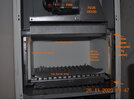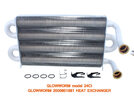I ask, because the boiler manual has very clear instructions on replacing this boiler part (the heat exchanger)0, and it is a two connections ‘water-side-only’ component – no gas involved at all. Any tips or potential pitfalls for a reasonably handy DIY-er would be gratefully received.
With help from one of your brethren, my boiler problem (of intermittent DHW flow – hot/cold) was diagnosed as my 20 year-old Glow-worm 24ci’s heat exchanger needing replacement: this was confirmed by my local heating engineer, who then went on to his “selling a new boiler” speech, and that it wouldn’t be worthwhile replacing the HX as (pick one) they were obsolete/no longer in production/unobtainable/so expensive a new boiler was my best route even if I found one, he wouldn’t like to guarantee the installation, and on and on.
A quick Google later, I found two main suppliers both holding stock on genuine branded new replacement parts – I bought one (it was expensive, they had that right!) but a beautiful piece of kit; it looks like a miniature car radiator, with two large connection pipes and a fitting kit comprising washers, clips and heat-transfer stuff in a tube (for when replacing the thermistor on the flow pipe).
The procedure runs as follows
====================================================================================
Please read the post about DIY Gas work.
Anything involving work on any part of the air, gas or exhaust flow through a boiler is gas work.
Breaking the seal to the combustion chamber is gas work.
You are hereby advised to turn off the gas at the control valve and call a Gas Safe registered operative.
You possibly could have fixed your blockage using additives to the circulating water. That is NOT gas work.
This post is left in case you want to try that route.
Any questions or answers regarding the work you have suggested is outside what we allow and will be removed when reported.
Mod.
====================================================================================
With help from one of your brethren, my boiler problem (of intermittent DHW flow – hot/cold) was diagnosed as my 20 year-old Glow-worm 24ci’s heat exchanger needing replacement: this was confirmed by my local heating engineer, who then went on to his “selling a new boiler” speech, and that it wouldn’t be worthwhile replacing the HX as (pick one) they were obsolete/no longer in production/unobtainable/so expensive a new boiler was my best route even if I found one, he wouldn’t like to guarantee the installation, and on and on.
A quick Google later, I found two main suppliers both holding stock on genuine branded new replacement parts – I bought one (it was expensive, they had that right!) but a beautiful piece of kit; it looks like a miniature car radiator, with two large connection pipes and a fitting kit comprising washers, clips and heat-transfer stuff in a tube (for when replacing the thermistor on the flow pipe).
The procedure runs as follows
- Switch off electrics and isolate boiler from cold water mains
- Close flow and return cocks and drain boiler, open one or more HW taps
- Remove front panel, sealed chamber cover, combustion chamber cover
- Remove the fan, electric cables disconnected
- Remove air pressure sensing tube from side of flue hood
- Release and remove two side panels, revealing the flow pipes connected to the HX down pipes
- Remove – lift off – flue hood
- Disconnect the electric leads from overheat thermostat (thermistor)
- Remove the two flow pipe securing clips and lift off the heat exchanger
====================================================================================
Please read the post about DIY Gas work.
Anything involving work on any part of the air, gas or exhaust flow through a boiler is gas work.
Breaking the seal to the combustion chamber is gas work.
You are hereby advised to turn off the gas at the control valve and call a Gas Safe registered operative.
You possibly could have fixed your blockage using additives to the circulating water. That is NOT gas work.
This post is left in case you want to try that route.
Any questions or answers regarding the work you have suggested is outside what we allow and will be removed when reported.
Mod.
====================================================================================
Attachments
Last edited by a moderator:




